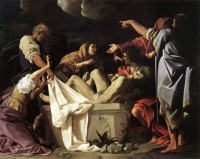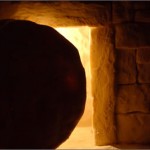Aside from the great physical suffering and pain that Jesus went through, He also experienced great spiritual suffering.

In the Garden
The first hint we get that Jesus went through spiritual agony is revealed in a physical manifestation. Jesus, on the night of His arrest, went to the Garden of Gethsemane to pray, “And He took with Him Peter and James and John, and began to be very distressed and troubled. And He said to them, “My soul is deeply grieved to the point of death…” (Matthew 26:37-38).
Interestingly, “Gethsemane” means olive press. Near the garden was an olive grove, and it was probably in this garden that the olive oil was pressed out of the olives. It is here that Jesus prays for God to let this cup pass from Him. He prays so fervently, and is in such deep anguish, that drops of blood came out of His skin. He was being pressed like an olive. Physicians tell us that this is entirely possible when a person is under extreme amounts of stress and pressure.
Bearing Sin on the Cross
 Though we can never know the spiritual agony that Jesus experienced on the cross, we see hints of it in what He says. For example, His fifth statement from the cross is “My God, My God, Why have you forsaken me?” Jesus, as the second person of the Trinity, has had constant fellowship with God the Father for all eternity. What must it have been like for Him now to have that relationship severed and broken? What must it have felt like for Jesus when our sin separated Him from God? Our sin broke the eternal fellowship of the Godhead!
Though we can never know the spiritual agony that Jesus experienced on the cross, we see hints of it in what He says. For example, His fifth statement from the cross is “My God, My God, Why have you forsaken me?” Jesus, as the second person of the Trinity, has had constant fellowship with God the Father for all eternity. What must it have been like for Him now to have that relationship severed and broken? What must it have felt like for Jesus when our sin separated Him from God? Our sin broke the eternal fellowship of the Godhead!
Whereas always before, Jesus had always prayed to God as “My Father,” He now referred to Him as “My God” the way other humans did. Sin had now separated Jesus from God. Where for eternity past there had been warm fellowship and a loving relationship, there was now only broken fellowship, a sense of deep and agonizing loss, a hopeless despair, and the blackness of depravity.
Being the sinners that we are, I think we do not understand the pain that this caused Jesus. We were born in sin, and are numb to it, and do not fully know that deep and intimate connection with God that we were made for. But even then, many of us experience deep guilt and regret over things that we have done. And yet few of us are murderers or rapists.
Imagine now being Jesus, never having sinned, never having known the pain and fear of guilt, never having felt hate or lust, now having the torrential flood of all the sins of the whole world placed upon Him in a few short hours. Every bad thought that has ever been thought, every adulterous affair, every hateful word, every act of theft or bribery, every whisper of gossip, every murder, every profanity, every act of disloyalty to wife, husband, or boss, every disobedient act of children toward their mother, father, or teacher –- all sin, of all the world, of all time was placed on Jesus Christ all at once.
Jesus took it all. He who had never experienced the pain of sin, took it all at once in a torrential downpour. It was beyond anything we can describe or understand.
But at least it was only for a few hours, right? Wrong.
The Eternality of Jesus
We’re going to delve into a little theology here.
Jesus, being God, is eternal. If we understand eternality correctly, then there are aspects of Jesus which are outside of time, and therefore, experience time not in a sequence, but in a constant “now.” This means that whatever Jesus experienced on the cross, He is always experiencing this in some sense. While it seems to us that Jesus only spent a few hours on the cross, in His experience, He is on the cross forever.
Of course, Jesus is not just experiencing His suffering on the cross, but also His death and victorious resurrection.
Suffering in the Grave
 Scholars widely disagree about what happened to Jesus after He died. Some believe He spent three days in hell. But based on a variety of reasons, I don’t believe so. Among other reasons, He told the thief on the cross, “Today you will be with me in paradise.” At most, Jesus went to a place called “Abraham’s Bosom.” There is also a whole study that could be done tracing the steps of the High Priest on the Day of Atonement, which I think Jesus followed in the “heavenly” temple.
Scholars widely disagree about what happened to Jesus after He died. Some believe He spent three days in hell. But based on a variety of reasons, I don’t believe so. Among other reasons, He told the thief on the cross, “Today you will be with me in paradise.” At most, Jesus went to a place called “Abraham’s Bosom.” There is also a whole study that could be done tracing the steps of the High Priest on the Day of Atonement, which I think Jesus followed in the “heavenly” temple.
So when we speak of Christ as spending three days in the grave, it was actually His body that was in the grave while He was spiritually in heaven before God presenting His sacrifice. After three days, He rejoined His body and rose from the dead. This, of course is what happens to all Christians as well. When we die, we spiritually go to heaven. Our bodies remain behind until the resurrection.
So while I don’t believe Jesus suffered in hell, this still does not diminish the great spiritual suffering that Jesus experienced as a result of taking on all the sins of all people in all the world throughout all history. But how thankful we can be that He did so, for it was only in this way that we can receive the righteousness of God (2 Cor 5:21).
The cross of Jesus is CENTRAL to everything!
Transform your life and theology by focusing on the crucifixion and resurrection of Jesus:
Fill out the form below to receive several emails from me about the death and resurrection of Jesus.
(Note: If you are a member of RedeemingGod.com, login and then revisit this page to update your membership.)





 The arm of the cross, or the horizontal part was then attached to the upright piece. Most often, we think of the cross as the one we so often see in pictures, with the horizontal piece about one-fourth to one-third of the way down the vertical piece. But historians and archeologists tells us that probably, the shape of the cross that Christ died on was more like a capital T than a lower case t. This piece was known as the patibulum, and it is this form of the cross that was most often used in Christ’s day. There was also an X-shaped cross, but this was rarely used in the days of Jesus.
The arm of the cross, or the horizontal part was then attached to the upright piece. Most often, we think of the cross as the one we so often see in pictures, with the horizontal piece about one-fourth to one-third of the way down the vertical piece. But historians and archeologists tells us that probably, the shape of the cross that Christ died on was more like a capital T than a lower case t. This piece was known as the patibulum, and it is this form of the cross that was most often used in Christ’s day. There was also an X-shaped cross, but this was rarely used in the days of Jesus.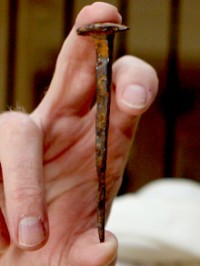 If the authorities wanted a quicker death, they would generally drive nails into the hands and feet of the victim. The nails were not driven into the palms of the hands as most pictures show. Rather, they were driven through the wrist near the hands. If the spikes were driven through the hands, the weight of the person would cause the nail to rip through the hands and the victim would fall off the cross. But when driven through the wrist, the set of bones which attach the wrist to the hand keep the hands from ripping free.
If the authorities wanted a quicker death, they would generally drive nails into the hands and feet of the victim. The nails were not driven into the palms of the hands as most pictures show. Rather, they were driven through the wrist near the hands. If the spikes were driven through the hands, the weight of the person would cause the nail to rip through the hands and the victim would fall off the cross. But when driven through the wrist, the set of bones which attach the wrist to the hand keep the hands from ripping free.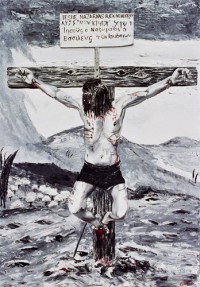 To take a breath, the victim would have to stand up on the nail through his feet, causing excruciating pain in the feet, but enabling him to take a breath. As long as he was putting all his weight on his feet, he could breathe. But when that became too painful, he would slump back down, putting all his weight on his wrists, and also returning to the condition of not being able to breathe.
To take a breath, the victim would have to stand up on the nail through his feet, causing excruciating pain in the feet, but enabling him to take a breath. As long as he was putting all his weight on his feet, he could breathe. But when that became too painful, he would slump back down, putting all his weight on his wrists, and also returning to the condition of not being able to breathe.
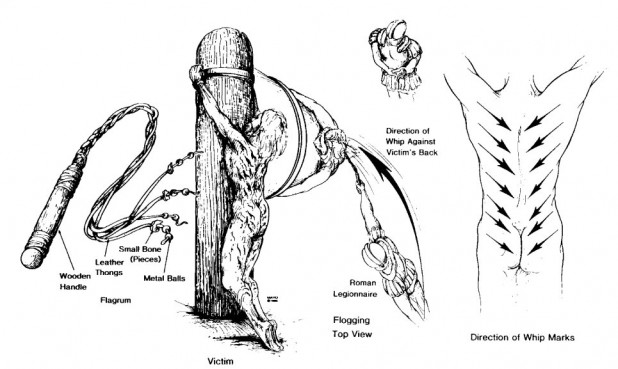
 The half-fainting Jesus is then untied and allowed to slump to the stone pavement, soaked with His own blood. The Roman soldiers see an opportunity to make a joke out of Him. Here is a provincial Jew claiming to be a king, but was now barely alive. So they throw a robe across His shoulders and place a stick in His hand for a scepter. To make the travesty complete, a small bundle of flexible branches covered with long thorns are woven into the shape of a crown and pressed into His scalp. Since head wounds always bleed a lot, the blood runs down His face and into His eyes.
The half-fainting Jesus is then untied and allowed to slump to the stone pavement, soaked with His own blood. The Roman soldiers see an opportunity to make a joke out of Him. Here is a provincial Jew claiming to be a king, but was now barely alive. So they throw a robe across His shoulders and place a stick in His hand for a scepter. To make the travesty complete, a small bundle of flexible branches covered with long thorns are woven into the shape of a crown and pressed into His scalp. Since head wounds always bleed a lot, the blood runs down His face and into His eyes.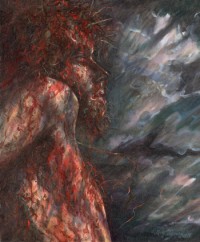 Most artists do not even come close in depicting what Jesus looked like after all of this torture. He was probably the most inhuman looking thing you’ve ever seen. The prophet Isaiah wrote of the Messiah: “They shall see the Servant of God beaten and bloodied, an object of horror; so disfigured many were astonished. His face and His whole appearance were marred more than any man’s, one would scarcely know it was a person…” (Isa 52:14).
Most artists do not even come close in depicting what Jesus looked like after all of this torture. He was probably the most inhuman looking thing you’ve ever seen. The prophet Isaiah wrote of the Messiah: “They shall see the Servant of God beaten and bloodied, an object of horror; so disfigured many were astonished. His face and His whole appearance were marred more than any man’s, one would scarcely know it was a person…” (Isa 52:14).
 His mission of atonement is nearly complete. Finally, He can allow His body to die. With one last surge of strength, He presses His torn feet against the nail, straightens His legs, looks into heaven, and utters His seventh and last cry, “Father, into your hands I commit my spirit.”
His mission of atonement is nearly complete. Finally, He can allow His body to die. With one last surge of strength, He presses His torn feet against the nail, straightens His legs, looks into heaven, and utters His seventh and last cry, “Father, into your hands I commit my spirit.”
 The differences between Christmas and Easter could be told as The Tale of Two Fridays.
The differences between Christmas and Easter could be told as The Tale of Two Fridays.